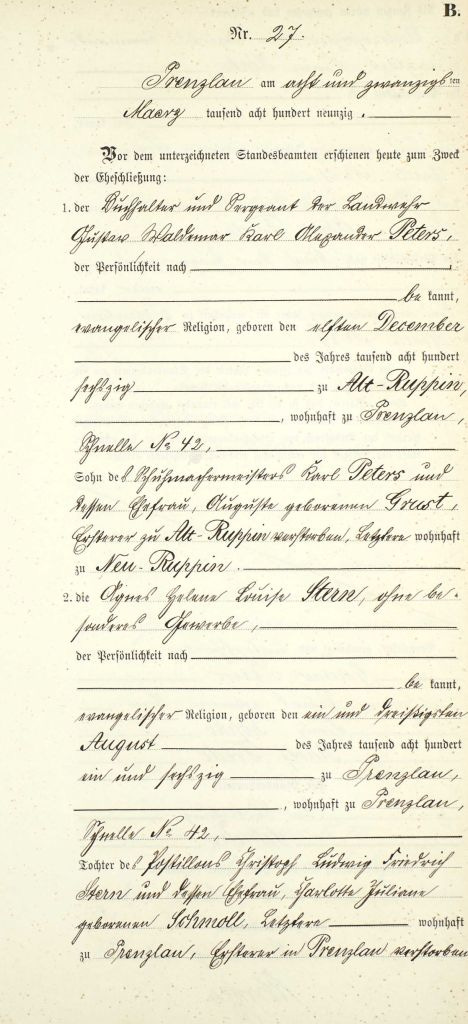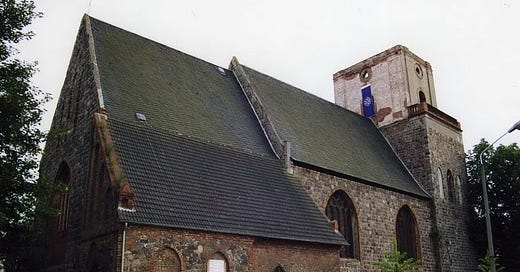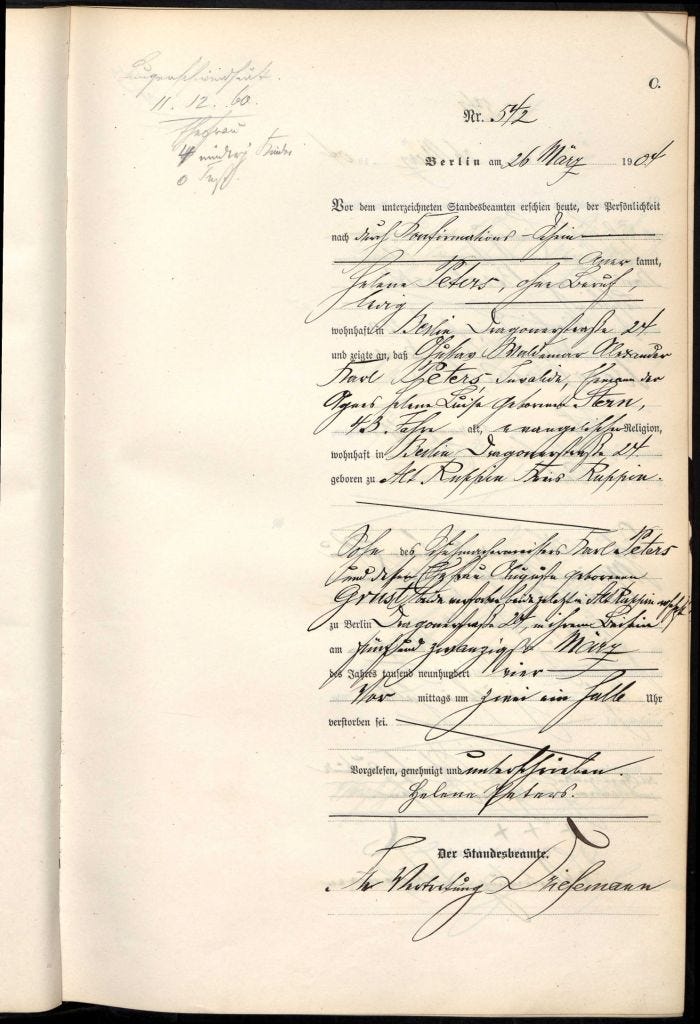My great great grandmother Agnes Helene Louise Stern, daughter of Christoph Ludwig Friedrich Stern and Charlotte Juliane Schmoll—seventh of their nine children—was born on 31 August 1861. She was baptised on 6 October 1861 at Sankt Jakobi, Prenzlau.
In Germany in the nineteenth century children were usually given three names. One of the middle names was used as the personal forename; Agnes Helene Louise was always known as Helene.
Prenzlau, the district town and administrative seat of the Uckermark region of northern Brandenburg, was historically the capital of the Uckermark. It had an army garrison and, from 1863, its own railway station, inaugurated by King Wilhelm I of Prussia.

Early Life & Family Background
Helene’s father, Friedrich worked as a postillion (mail coach driver) before becoming an assistant railway inspector (Aufsichts-Inspector) of the Prenzlau Royal Railway Station. In 1868, when Helene was six, her father died at the age of forty-seven, possibly from pulmonary tuberculosis. This left her mother a widow with six young children.
Marriage & Legitimisation of Children
Helene bore two children before her formal marriage to Gustav Waldemar Karl Alexander Peters on 28 March 1890 in Prenzlau. On both birth registrations she was described as ‘unmarried seamstress’. The births were registered by the father, Gustav.
At the time of these births—of Auguste Helene Juliane (1884) and Helene Auguste Minna (1889)—Gustav was an active-duty Unteroffizier (non-commissioned officer) in the Prussian Army, where he was subject to strict military marriage laws. A soldier was required to obtain permission before marrying and was obliged to prove that his financial circumstances were stable. This delayed many formal unions. But by 1890, having moved to the Landwehr (militia), Gustav was able to marry Helene and legitimise their daughters, allowing them to take their father’s surname and granting them inheritance rights.


Gustav’s Civilian Career
In the mid-1890s, Gustav left military service and became a railway worker in Berlin. Birth records of his children list him as an Eisenbahnarbeiter (railway laborer) and later a Linienarbeiter (line worker), likely involved in track and telegraph construction. He remained employed in this capacity until his death in 1904.
Family Life in Berlin
By 1894, the family had settled in Berlin, where their son Karl Gustav Ernst was born. In 1895, when Helene’s mother Charlotte Stern died, Gustav Peters was the informant on the death certificate.
In 1898, their youngest child, Charlotte Auguste Helene, was born. Gustav’s occupation was recorded as Linienarbeiter.
Gustav’s Death (1904) & Agnes’s Later Years
In 1904, Gustav died at the age of forty-three. Helene, also forty-three, now a widow, continued to live in Berlin.
In 1918, Helene died at the age of fifty-six. Her son Karl Peters reported her death. He gave her parents’ names wrongly, however, which perhaps suggests that he knew very little about them.
Related posts and further reading
G is for Gustav concerning Gustav Waldemar Alexander Karl Peters (1860-1904), husband of Agnes
P is for Pankow concerning cousins on the Stern side of the family
Johnson, B. (2017). Marriage Laws and Customs in Germany. FamilySearch. https://www.familysearch.org/en/wiki/img_auth.php/2/2e/German_marriage_handout_templated_jan_2017.pdf
Wikitree: Agnes Helene Louise (Stern) Peters (1861 – 1918)
First published at https://anneyoungau.wordpress.com/2025/04/01/a-is-for-agnes/




Great post. Have you been to the Uckermark? A beautiful part of Brandenburg, very popular with the Berliners.
I like the way you have used links to outside sources. The German marriage customs are interesting. The English are far more likely to have closer consanguinial relationships and marriage.